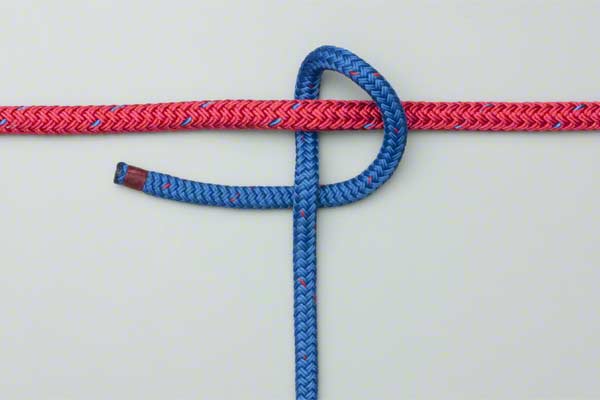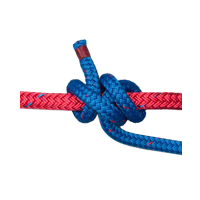Cow Hitch (Lanyard Hitch) using the End Tying
Pass the rope around the object, back around itself, around the object in the reverse direction, and down beside itself.






Cow Hitch, (Lanyard Hitch) using the End Details
Alternative: In addition to Threading the End, the Cow Hitch can be tied Using Loops.
Description: The Cow Hitch or Lanyard Hitch (ABOK # 1673, p 290) is similar to the Clove Hitch except that the second Half Hitch is in the reverse direction.
Why Include it Here? It answers the question: "What happens when I tie a Clove Hitch but reverse the second turn?" Answer: "A Cow Hitch." The Clove Hitch and the Cow Hitch are close relatives with similar properties. Neither should be trusted alone for critical applications.
Similar Knot: The Cow Hitch has a similar appearance to the Girth Hitch, which is tied with a sling loop and known by various names including Strap Hitch and Bale Sling Hitch.
Names: In addition to "Lanyard Hitch", the Cow Hitch is also known as the "Lark's Head" – attributed to a literal translation from the French "tête d'alouette" (ABOK # 5, p 11). The subsequent transformation from "Head" to "Foot" originated in Modern Rope Techniques in Mountaineering by (the late) Bill March in 1973. He probably meant to say Lark's Head, but made a mistake when he showed it used for a foot loop.
Uses:
- Archery: To protect the bowstring from damage caused by the mechanical release, the two ends of a short line are tied to the bowstring to form a "D-Loop". Each end is attached to the bowstring using a Cow Hitch – made more secure by heating each end to from a "Blob". Discussions in on-line forums acknowledge this can fail and some have experimented with using a Constrictor instead.
- General: The Cow Hitch can be used as an alternative to the Clove Hitch. It can be used to secure a lanyard to a rope. It is just as likely to slip as the Clove Hitch but less likely to bind and be hard to untie. Although named the "Cow Hitch", Ashley comments (ABOK # 244, p 44) that the Clove Hitch was used to secure cows more often. He went on to describe watching as a cow, secured by a Clove Hitch, walked in a circle that unwound and untied the Clove Hitch. For this purpose at least, the Cow Hitch appears to be better suited to the task.
Pros and Cons: It is one of the quickest and easiest knots to learn but has relatively few critically useful applications.



